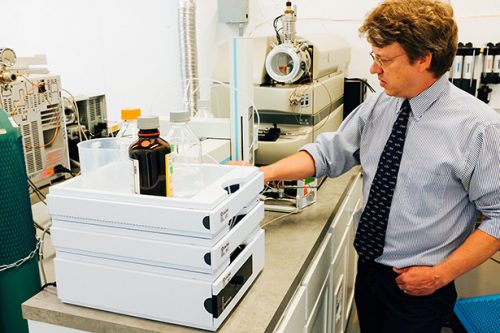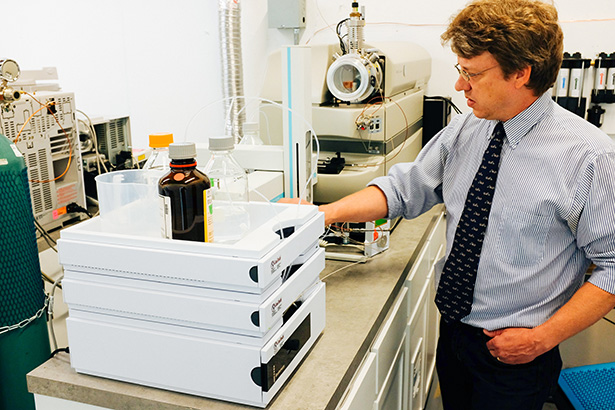
Five years ago a friend handed Will Thysell a piece of “shatter.” The glossy golden marijuana extract immediately intrigued him.
“I just had never seen anything like it,” Thysell says. “The look, the taste, the feel, was completely new.” He tried the potent extract and knew it could help a loved one in chronic pain. His godfather had scarring on his heart and lungs caused by severe shingles — a condition he described as a million burning-hot needles poking him.
“I gave him a dab of it and he just let out this relaxed breath, and he said, ‘It’s like a warm blanket evaporating my shingle pain,” remembers Thysell, who owns Next Level Wellness, a medical marijuana dispensary in South Eugene. “At that point I immediately knew I was going to take it upon myself to do two things: make sure he had enough of it as he needed and that it was going to be as clean as a product that it possibly could be.”
In cannabis circles, stories like Thysell’s are not uncommon: marijuana as a medicine that alleviates ailments like no drug traditionally found in a prescription bottle ever could. Now that medicine comes in more forms than ever. Shatter is a form of butane hash oil (BHO), a cannabis extract or concentrate, which has skyrocketed in popularity in recent years.
The tacky substance has many names for its varying shapes and viscosities — shatter, wax, dabs, resin, budder, honeycomb, honey oil, crumble or even gummy wax (think cannabis gummy bears).
BHO is arguably the strongest medicine that falls beneath cannabis’ growing umbrella of byproducts, with a range of THC (tetrahydrocannabinol, the psychoactive chemical in pot) averaging 65 to 90 percent. The strongest marijuana flowers typically have THC potency below 20 percent.
The question of the hour, however, isn’t whether BHO is effective as medicine, but whether it’s clean and safe to use. The answer seems to be alarmingly no — at least, not yet.
There is a big, dirty elephant stomping through marijuana crops that most people in the industry, along with the Oregon state agencies that oversee it, aren’t informing the public about: pesticides.
Consumers are unknowingly ingesting and inhaling concentrated pesticides at unprecedented levels when using BHO, more so than when consuming marijuana flowers. Found on the shelves of your local dispensary and made illegally in homes across the country, BHO has tested positive for toxic levels of pesticides, many of whose chemical compounds have been linked to cancer.
In addition, any pesticide use on cannabis crops is technically illegal, as it has not been approved by the Environmental Protection Agency (EPA), the federal body charged with regulating pesticides.
Meanwhile there is no regulation, accreditation or tracking of cannabis testing labs by the state.
Welcome to the Wild West of weed.
 |
|
‘We not only don’t have to report our findings, there is in fact nowhere to report them, and i haven’t found anyone in the state system that seems to care,’ says Rodger Voelker, lab director for OG Analytical. Photo by Trask Bedortha.
|
The White Papers
“Pesticide use on cannabis is an emerging public health threat.”
That’s the first line in the introduction to “Pesticide Use On Cannabis,” a study released in June 2015 by Eugene chemist Rodger Voelker and Portland biologist Mowgli Holmes. The study is part of a series of white paper reports on cannabis available to the public at cannabissafetyinstitute.org.
The white paper continues, “The data in this paper indicate that pesticides can now be found on close to half of the cannabis sold in Oregon dispensaries. The potential dangers of this situation are magnified by the increase in popularity of cannabis extracts. These are made by processes that appear to concentrate pesticides, leading to extremely high levels in the final product.”
Nursing a cup of coffee at his desk in OG Analytical — a West Eugene cannabis-testing lab — Voelker is almost twitchy with concern over the report’s findings. As the lab’s scientific director, Voelker has a Ph.D. in molecular biology. He served as a chemist and a director for a pesticide residue analytical laboratory in the Oregon Department of Agriculture for several years before diving into the new frontier of cannabis analysis.
The report, Voelker says, “includes the initial data we gathered over a six-month period, demonstrating that there is a real concern there, yes.” Voelker and Holmes tested for more than 65 compounds in 389 samples of Oregon marijuana flowers and 154 samples of concentrates. It should be noted, however, that not all concentrates are BHO (e.g., tinctures).
Voelker shared the findings with The Oregonian, published in a June 11 special “Watchdog” report. “A Tainted High” is an exhaustive but general investigation about how “lax state rules, inconsistent lab practices and inaccurate test results put pesticide-laced pot on dispensary shelves.”
But more so than concerns about pesticides on pot flowers, the white paper shows that BHO is consistently showing the highest levels of pesticide contamination, from insecticides such as befenthrin and carbaryl, the fungicide myclobutanil (commonly found in Eagle 20) and piperonyl butoxide (PBO), an organic compound used in pesticides to enhance toxicity of active ingredients.
The report says that pesticides “appear to be 10x higher in concentrates versus flowers.” The EPA has classified many of these compounds as possible or likely human carcinogens.
The findings continue: “Even more alarming is the discovery that some concentrates contain compounds such as PBO, carbaryl, myclobutanil and chlorfenapyr at levels greater than 100,000 ppb [parts per billion]. These levels grossly exceed tolerances for pesticides on any commodity, and it is important to note that chlorfenapyr is not registered for use on any food commodities.”
In addition to testing for THC, CBD (cannabidiol), mold and mildew, the state of Oregon requires the Oregon Medical Marijuana Program (OMMP) only test for four compounds used in pesticides: chlorinated hydrocarbons, organophosphates, carbamates and pyrethroids. Any batch of marijuana that tests above a tolerance of 100 ppb for these pesticides, in theory, should be failed and not sold.
“However, the bulk of pesticides actually used on cannabis don’t fall into those categories,” Voelker says. “The way people are reading that effectively is: It’s OK to use everything else.”
Later in an email to EW, Voelker writes: “Thus when I find other pesticides, even if they are present at obscene levels, I have no authority to ‘fail’ the sample and it can be sold. This despite the fact that the EPA has not established tolerances for these compounds on cannabis and thus any detection is in violation of federal law.”
Concluding, he writes, “we not only don’t have to report our findings, there is in fact nowhere to report them, and I haven’t found anyone in the state system who seems to care. All we can do is issue a certificate that indicates our findings. The grower/supplier is free to do whatever they want with the material.”
In short, the state of Oregon, as well as other states that have legalized marijuana use, is operating in a legal gray area. The EPA requires that pesticides be used only as the agency has directed. And because marijuana has not been legalized on a federal level, all use of pesticides on cannabis crops is technically illegal, even the ones OMMP requires labs test for. The only agency that can regulate it, won’t regulate it.
As of July 1, when recreational marijuana becomes legal in Oregon, there will be no new rules for pesticides in place.
“All that we have as far as regulation of pesticides is related to the medical marijuana dispensary program,” says Tom Towslee, the recreational marijuana public affairs officer for the Oregon Liquor Control Commission, which has been tasked with regulating recreational marijuana.
“We want to make sure all the marijuana sold through the recreational program is safe,” Towslee adds. “We would require that recreational marijuana be tested at a certified lab.” However, he says that no rules are currently in place to enforce this and it’s up to the Oregon Legislature to put regulations in place, which he says is “a moving target right now.”
Risk to Public Health
What exactly the public health concerns are at this point remain a bit of a question mark.
Jonathan Modie, communications officer for the Oregon Public Health Division, which houses OMMP, tells EW that pesticide use on cannabis “is a concern for us for public health reasons.”
There is very little peer-reviewed research on the effects of consuming pesticide-contaminated marijuana, especially in the concentrated form of BHO.
However, one 2013 peer-reviewed study by a California analytical testing lab — “Determination of Pesticide Residues in Cannabis Smoke” — states that “the potential of pesticide and chemical residue exposures to cannabis users is substantial and may pose a significant toxicological threat in the absence of adequate regulatory frameworks.” The study also found that up to 69.5 percent of pesticide residues are present in smoked pot.
In addition, the National Pesticide Information Center (NPIC), based in Corvallis, cites many of the chemicals Voelker and Holmes identified in the white paper study as linked to cancer. For example, NPIC’s carbaryl fact sheet states that the EPA considers carbaryl “likely to be carcinogenic to humans.”
Meanwhile, Beyond Pesticides, a Washington, D.C., nonprofit, states that PBO — the most commonly detected compound in the white paper study — is a “highly toxic substance that causes a range of short- and long-term effects, including cancer and adverse impacts on liver function and the nervous system.”
 |
| Will Thysell, owner of Next Level Wellness and White Label Extracts, has been making butane hash oil for five years. Photo by Todd Cooper, |
Labs in the Wild West
On a Friday afternoon in June, Will Thysell and Nick Landis sit in the back office of the Herbal Center, a dispensary run by Landis in north Eugene. Considered an extract expert in the industry, Thysell owns the extract company White Label Extracts. Landis also owns an extract company — Top Shelf Extracts.
“The downside of BHO that we’re battling right now is a pesticide issue being used on top of the flowers,” Landis says. “And inconsistent lab testing with that.”
Lab testing is a crucial step between harvesting marijuana crops and selling those crops at your local dispensary, and yet the process is almost completely unregulated by the state of Oregon.
“It’s probably one of the biggest problems in our industry and probably one of our biggest headaches,” Landis says. “It’s hard because the state hasn’t set any tolerances and there hasn’t been any standards set for these labs, and they are all free to run in how they look at things.”
Landis and Thysell say they try to control the issue the best they can by investigating the labs they use and meeting with growers about pesticide use. Many in the industry told EW that it’s not unusual for growers and dispensaries to shop around for passing grades at different labs, and for labs to accept bribes to pass a marijuana batch regardless of pesticides detected. Many also said inflating THC numbers is rampant.
“This is where having relationships with growers you know and being responsible about the material you’re intaking is very important,” Landis says.
For a dispensary, that’s an enormous task — regulatory oversight of an industry — better suited to a state or federal agencies who have the infrastructure, budget and expertise.
“The way Oregon crafted House Bill 3460,” Thysell says of 2013’s medical marijuana dispensary bill, “created a disaster waiting to happen in terms of lab testing because what they said was, everything has to be tested. So that’s immediately going to create this huge laboratory industry in Oregon — it’s big business.”
“There’s no third parties watching these labs,” he continues. “It’s up to them to do their own quality control.”
Thysell uses Cascadia Labs in Bend and Oregon Analytical and OG Analytical in Eugene. Landis also uses Oregon Analytical and OG Analytical.
“OG Analytical is on the frontlines of some of the laws changing and setting the standards,” Landis says, noting that lab owner Bethany Sherman “is working very hard to make sure there is some laboratory standards set. She’s not into cutting corners whatsoever.”
Quality Control
Bethany Sherman is the founder of OG Analytical, the lab that Voelker directs. Sherman says she never anticipated getting involved with the cannabis industry until her mother was diagnosed with multiple sclerosis, right around the same time HB 3460 was signed into law.
“So I launched a pretty deep personal research investigation on the efficacy of cannabis and how it interacts with the body and the potential risk for pesticides,” Sherman says. “There are certain pesticides that if you ingest when you have MS, that can exacerbate the disease.”
She continues, “I started looking around for what types of quality-control procedures are in place to ensure that my mom would be safe if she were to be consuming cannabis.”
At the time, circa late 2013, Sherman only found two cannabis analysis labs operating in Oregon, neither of which were testing for pesticides. “It was an obvious gap that needed to be filled,” she says.
And thus Sherman drafted a team for her lab, including Voelker, and started operating in the spring of 2014. OG Analytical has taken it upon itself to test for compounds found in pesticides that are not mandated by the state.
“Unfortunately, every state is reliant upon itself,” Voelker says. “Normally these things are all handled at the federal level. Consumer protection is a federal responsibility.”
He also concedes that “these state agencies are tasked with a lot of other things and they have limited budgets too. This is a real challenge.”
It is uncertain at this point how the state will address this public health concern, though the Oregon Liquor Control Commission, tasked with regulating recreational marijuana, has recently created a Marijuana Rules Advisory Committee and four technical committees that will address issues like compliance and enforcement, lab accreditation and different marijuana products like extracts, topicals and edibles.
Sherman sits on the Lab and Traceability committee, which she says held its first meeting in June. The last meeting is scheduled for October, with the expectation that a set of rules for regulating labs and testing will be developed by then.
Sherman says her committee is focused on accreditation — “the state licensing and accreditation for labs, because that’s something that doesn’t exist at all for today.” She adds, “Within that, we need to develop a good solid target list for which pesticides we’re going to be looking for.”
Voelker’s study also has a list of recommendations for the state.
BHO ON THE RISE
In the meantime, use of BHO and concentrates is on the rise. Flip through any marijuana publication or visit dispensary websites and find a seemingly endless stream of advertisements peddling glistening gold concentrates heralded as “pure,” “clean” and “safe” medicine.
Marianne Slason, a BHO consumer and owner of the Santa Clara Smoke Shop, says the use of BHO is “very prevalent here.” She adds, “My vaporizer pens for concentrate are one of my number-one sellers.”
Landis and Thysell agree.
“We’re seeing the usages of [BHO] increasing, especially with the use of these vaporize pens and the cartridges and everything,” Landis says. “I think the demographic is growing every day on who’s using it.”
Have more questions? So do we. OG Analytical will start hosting a free monthly educational series — Cannabis Science Pub — 6 to 9 pm Tuesday, June 30, at Cozmic. The focus of the first pub is “Legalization 101,” with guest speakers from the Emerald Trade Alliance, the Eugene Police Department and the Constant Gardener. OG Analytical will also present on cannabinoids, terpenes and, of course, cannabis testing.